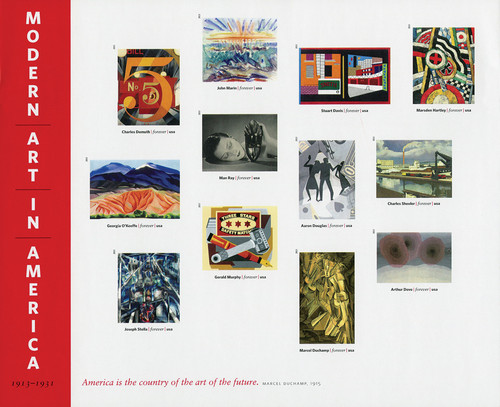
2013 First-Class Forever Stamp,Modern Art in America: Charles Sheeler's "American Landscape"
# 4748h - 2013 First-Class Forever Stamp - Modern Art in America: Charles Sheeler's "American Landscape"
$2.25 - $3.75
U.S. #4748h
2013 46¢ Charles Sheeler
Modern Art in America
Issue Date: March 7, 2013
Quantity: 1,950,000
Perforations: Serpentine Die Cut 10 1/2
Color: multicolored
Perforations: Serpentine Die Cut 10 1/2
Color: multicolored
Charles Sheeler’s painting American Landscape is one of twelve featured on the Modern Art in America: 1913-1931 stamps.
In the spirit of modern art, photographer and painter Charles Sheeler removed all traces of nature and humanity from his works, leaving simply machines and buildings – symbols of the modern age.
Sheeler (1883-1965) found early success at a painter but quickly realized it would not pay the bills. With a five-dollar Brownie camera, he taught himself photography and found even greater prosperity in that commercial field. He did high-profile celebrity and fashion shoots for Vogue and Vanity Fair. But he found his greatest joy in photographing the mechanical.
In 1927, Henry Ford hired Sheeler to photograph his car factory for an advertisement. Sheeler’s almost-haunting images show few people and focus on the massive machinery. He was later hired by Fortune Magazine to travel the country and produce a series of paintings that “reflect[ed] life through forms.” The resulting paintings had few people and pictured various types of machinery.
For his personal art, Sheeler further focused on the man-made. His home’s 19th century stove, that he called his “companion,” was the subject of countless photographs. Perhaps most representative of his style is his 1930 painting, American Landscape, which pictures no nature at all, but instead a factory. According to one source, as far as he was concerned, “The ancient tension between nature and culture is over. Culture has won.”
U.S. #4748h
2013 46¢ Charles Sheeler
Modern Art in America
Issue Date: March 7, 2013
Quantity: 1,950,000
Perforations: Serpentine Die Cut 10 1/2
Color: multicolored
Perforations: Serpentine Die Cut 10 1/2
Color: multicolored
Charles Sheeler’s painting American Landscape is one of twelve featured on the Modern Art in America: 1913-1931 stamps.
In the spirit of modern art, photographer and painter Charles Sheeler removed all traces of nature and humanity from his works, leaving simply machines and buildings – symbols of the modern age.
Sheeler (1883-1965) found early success at a painter but quickly realized it would not pay the bills. With a five-dollar Brownie camera, he taught himself photography and found even greater prosperity in that commercial field. He did high-profile celebrity and fashion shoots for Vogue and Vanity Fair. But he found his greatest joy in photographing the mechanical.
In 1927, Henry Ford hired Sheeler to photograph his car factory for an advertisement. Sheeler’s almost-haunting images show few people and focus on the massive machinery. He was later hired by Fortune Magazine to travel the country and produce a series of paintings that “reflect[ed] life through forms.” The resulting paintings had few people and pictured various types of machinery.
For his personal art, Sheeler further focused on the man-made. His home’s 19th century stove, that he called his “companion,” was the subject of countless photographs. Perhaps most representative of his style is his 1930 painting, American Landscape, which pictures no nature at all, but instead a factory. According to one source, as far as he was concerned, “The ancient tension between nature and culture is over. Culture has won.”









